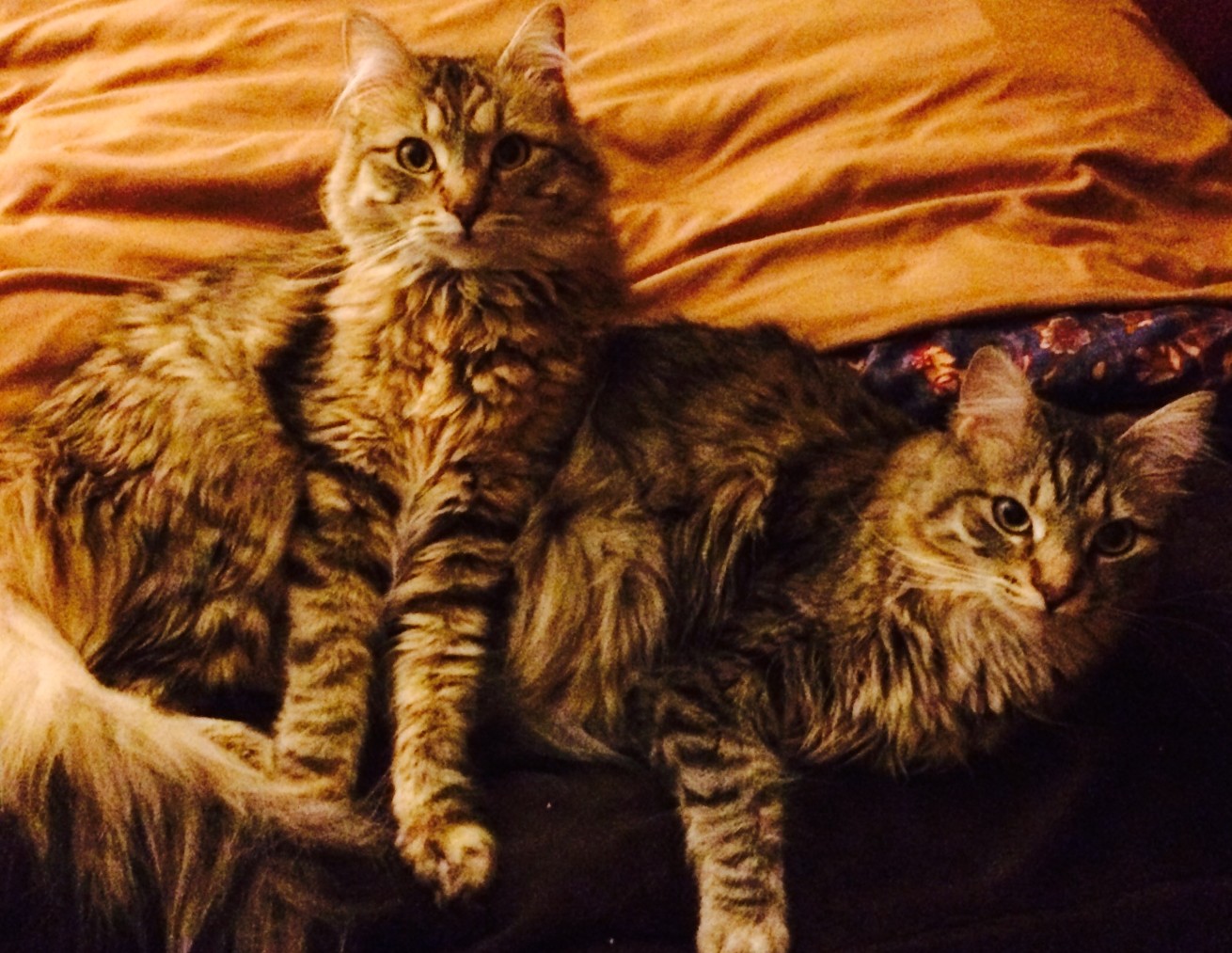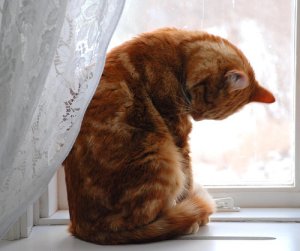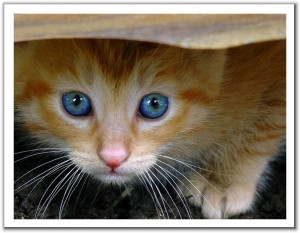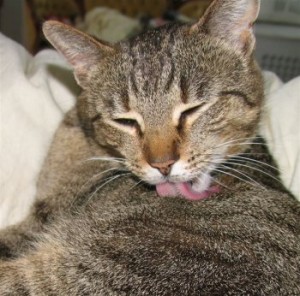How to Keep Your Cat Indoors and Happy
Cats are naturally curious and active creatures, and with so many different personalities among the feline population, they can be incredible and fun companions. Depending on where you live, you may want to keep your cat indoors or let it go outdoors. Many people choose to keep their cats indoors because it is definitely much safer for the cat, and for the wildlife in the area. Dangers to cats that live outdoors include getting picked up by a humane shelter or another person, getting run over by cars, getting in fights with other animals, getting killed by dogs or coyotes, being chased away by other animals, getting lost, being exposed to outside temperatures, climate changes, and bad weather conditions, and contracting illnesses among other things, including accidental pregnancy if the cat is not fixed, which, I hope you already know is absolutely necessary in this day and age. In any case, while having an indoor cat requires a bit more responsibility, you’ll soon learn that sharing your life with a feline is simply… awesome.
However, it is not always easy to condition a cat that has had a taste of the wild to live indoors.
 Indoor and outdoor cats are practically two different species. Indoor cats are much more dependent on you for food and water, and you should always provide and keep clean areas for them to use the bathroom and sleep. Outdoor cats, on the other hand, are much more independent as they adapt to their surroundings. While they still rely on you for food, water, and shelter, they also know how to hunt their own prey and find alternative places to sleep if it so pleases them. The world is their litter box, so you don’t have the responsibility of keeping one clean for them (unless, of course, they choose to use your garden for this). But, how to keep your cat indoors once it’s used to being outside?
Indoor and outdoor cats are practically two different species. Indoor cats are much more dependent on you for food and water, and you should always provide and keep clean areas for them to use the bathroom and sleep. Outdoor cats, on the other hand, are much more independent as they adapt to their surroundings. While they still rely on you for food, water, and shelter, they also know how to hunt their own prey and find alternative places to sleep if it so pleases them. The world is their litter box, so you don’t have the responsibility of keeping one clean for them (unless, of course, they choose to use your garden for this). But, how to keep your cat indoors once it’s used to being outside?
Now, you may wonder, are indoor cats happy? The answer to this question is yes, but you have to consider different situations. A cat that has never lived outside, or is very young, will adapt to indoor life just fine. As long as they have food, water, a clean litter box, and their own special areas to sleep and play, they are easy to keep happy and typically won’t attempt to leave the house as they are content in their own space.
When you bring an outdoor cat inside after they have already lived outside, you may face a bit of trouble. Outdoor felines already have a system down, and are accustomed to going wherever they please. Now that they are confined to a smaller living space, they may, at first, be hostile and upset towards their environment. This is why helping them adapt to their new area is vital.
Establish a feeding time, keep fresh water, and make sure you keep the litter box in the same place and out of the way of human traffic, at least until they get used to their new home. Allow them to explore and recognize the scent of your house, and let them find corners for them to snuggle into and claim as their own. Make sure you use cat condos or shelves on the walls where they can climb and observe their new world.
For a few days after he or she has been brought into your home, keep an eye on them and note their behaviors. Do they seem distressed? Distract them with play toys and let them continue exploring their space. Getting them accustomed to all of the new sights and smells will help them to adapt better.
The thing that you must remember when thinking about how to keep your cat happy indoors is that every feline is different. Some cats will be just fine in their new environment right away, while others will take a little longer. Either way, cats can be happy indoors as long as you maintain and keep their living areas clean, and show them the nurturing love and care that they need and deserve to survive. Don’t make the mistake of thinking that once you own a cat you should just “let it be” because they are so independent. Cats need stimulus and attention too. Provide them with scratching posts and toys, play with them every day, and any outdoor cat will soon know that it’s always a good thing to be inside.
Learn the Cat Tail Language
Cats are highly communicative animals and the way your cat moves its tail is a language unto itself. Your Cat’s tail movements serve as words to the discerning cat owner, who is then able to gauge the emotions of their beloved pet. In fact, cat tail wagging works in telling you various things with varying degrees of emphasis. Below is a decoding of the cat tail language and the cat tail meaning.
When you observe the tail of your cat, you will sometimes notice that it shakes or quivers. This cat tail movement may mean various things depending on how fast and the area at which the tail is quivering. Mild irritation is typically denoted by a quick shiver of the tip of the tail. On the other hand, when your cat is feeling happy or frisky, they are likely to show this by an all over shiver of their tail.
When your cat swishes their tail back and forth, this is when they are at their most primal state. When in the wild, cats stalking prey are known to swish their tails back and forth to encourage their prey to move. Once this happens, the cat will zero in on the prey and attack. This cat tail wagging means the same thing when your house cat flips their tail quickly back and forth.
Take the time to observe your cat’s tail at a moment when they are relaxed. You will find that they will often wave their tail from side to side. This is a movement that means that your cat is happy and is hoping for some loving attention.
On the other hand, when your cat flips their tail quickly, this means that they are ready to attack you if you do not back off at once. This is typically meant as a warning to you that they have been petted enough and would now like to be left alone. At this point, you are better off leaving them alone until they relax.
When you cat strolls around with its tail held high, this is a message to let everyone in the vicinity know that he is present and in charge. This is a healthy signal that demonstrates that you cat feels like they belong, and that they are happy and contented.
On the other hand, when the cat’s tail is lowered and fluffed out, this means that at that moment the cat is very afraid of something. During sleep, if your cat flips their tail, this is normally because they are dreaming. This cute action could signify that they are hunting in their dream.
What to Expect With Cat Diabetes
Lately I have been talking to a lot of people that have just found out their cat has diabetes, and most of them were panicking. Of course it’s a shock to hear your vet say your pet is diabetic and the news can be overwhelming, but you have to know that cat diabetes is a very treatable and manageable condition.
First off, let’s talk about the symptoms of cat diabetes that you might observe if your cat has the disease. You might notice frequent urination, drinking lots of water, eating a lot more, and maybe unexplained weight loss. In more advanced cases, you will see a loss of appetite, vomiting, weakness, acetone smelling breath, dehydration, labored breathing and lethargy. The vet will consider all these cat diabetes symptoms and do lab work to look for ketones in the urine and a high blood glucose level and the diagnosis will be made.
Having diabetes is not a death sentence for your cat. Of course, if the cat has other health problems things can get complicated, but even an older cat can live many more years if its diabetes is controlled appropriately. Before you even think of putting your pet to sleep, have a long talk with your vet and explore all the options to treat a cat.
It’s important to know that caring for a cat with diabetes will take a strong commitment on your part and the help of your vet. You need to provide special care every day, and your routine is obviously going to change and get a little bit more complicated, but don’t think you will now be a slave to your cat. Yes, you will have to give it medication, be careful with its diet and watch its behavior closely. Sometimes you’ll be able to control the diabetes with oral medications, others, you will need to give insulin injections. Don’t worry, it’s easy to learn to inject your pet and the injection is not painful at all.
Since most obese cats are prone to diabetes, it’s important to alter your cat’s diet, so if your cat is overweight, you will need to help him lose weight.
Although cat diabetes is not totally reversible, the need for treatment might ease up. If the diabetes was caused by obesity, it will improve a great deal after losing the weight. Regardless, all diabetic cats do best with consistent medication and feeding and a stress-free lifestyle. All the hard work will pay off when you get to enjoy many more years of love from your beloved pet.
Try to work with a vet that has had experience treating diabetic animals. The relationship with your veterinarian will be more important now, and good communication is key. You will have a lot of questions and your vet should be able to answer them in a way you can clearly understand the answers.
There are standard treatment options for cat diabetes, but every animal responds differently to different treatments, but don’t get frustrated, you and your pet will get through it.
There is tons of information about diabetes and diabetic cat diets, and although you will not have to become an expert, it will help for you to learn as much as you can about the disease and its treatments and management. Ask all the questions you need to ask, even if you think it’s something simple. Your pet’s life might depend on it.
The cost is what sometimes makes people panic when they find out the diagnosis. The financial requirements to take care of a diabetic animal can be overwhelming. But know that many vets will be willing to work on a payment plan for you and will help you limit expenses. Discuss all your options with your vet. If he or she is not willing to cooperate, look for a vet who will.
The expenses might be higher on the first few weeks while you and your vet are in the process of getting your cat’s diabetes regulated, since you will have to take it in for regular checkups in the early stages of the disease which are crucial to determine if there needs to be adjustments to the medications.
 Sometimes, the diabetes is quickly regulated, but some pets are not so lucky and they need more visits to the vet’s office. Once the diabetes is under control, the expenses will decrease. Supplies like syringes, insulin and special diet can cost around $30 to $60 per month. If you need to test your pet’s urine you can buy test strips for less than $15 for 50 test strips. If you need to test the blood glucose you can learn to do it at home to avoid the high cost of vet visits, but you will still need the cooperation of the vet to interpret the results. Blood glucose meters and test strips vary in price, but you can always fins rebates and coupons. But normally, the vet visits should be every six months once the diabetes is regulated.
Sometimes, the diabetes is quickly regulated, but some pets are not so lucky and they need more visits to the vet’s office. Once the diabetes is under control, the expenses will decrease. Supplies like syringes, insulin and special diet can cost around $30 to $60 per month. If you need to test your pet’s urine you can buy test strips for less than $15 for 50 test strips. If you need to test the blood glucose you can learn to do it at home to avoid the high cost of vet visits, but you will still need the cooperation of the vet to interpret the results. Blood glucose meters and test strips vary in price, but you can always fins rebates and coupons. But normally, the vet visits should be every six months once the diabetes is regulated.
Although all the changes to you and your cat’s lifestyle can be stressful, just keep in mind that the period of adjustment will be worth it in the long run and keep the end goal in sight.
There may be times when other illnesses arise, and every health crisis can be emotionally draining. But know that the bad times tend to pass and don’t forget to celebrate the progress that you have made, even if it’s just a tiny step. Animals can perceive your emotions and the power of love to heal your pet should never be underestimated.
When you need to take a vacation, you need to make sure to make arrangements for a well trained care-giver to take over the care of your cat during your absence. They will need to administer medications, feed them and observe your pet’s behavior in order to call the vet if a problem arises.
You have a lot to learn, so be patient with yourself so you can make the best and most loving decision for everyone.
Photos courtesy of Mel B.
Congratulations! You have a pregnant cat!
Cat owners are growing more responsible every day and do their best to keep their cats spayed or neutered. However, if for whatever reason you did not spay your female cat and she happened to find an intact male in one of her outings, well… congratulations! You have a pregnant cat! But, what do you know about cat pregnancy? Do you even know how long are cats pregnant?
Even when you think your cat is purely an indoor cat, females in heat have only one thing in their mind, and that’s to find a tom to get them pregnant.
 First thing you should know is that a cat pregnancy or gestation period is about 9 weeks, and that there’s really nothing you can do. Nature, in all her wisdom, will take over and your cat will become a wonderful mother on her own. But you can still prepare yourself and your home for the new family and give the pregnant cat a little help.
First thing you should know is that a cat pregnancy or gestation period is about 9 weeks, and that there’s really nothing you can do. Nature, in all her wisdom, will take over and your cat will become a wonderful mother on her own. But you can still prepare yourself and your home for the new family and give the pregnant cat a little help.
What can you expect if your cat is pregnant?
You will notice that your cat gets a lot more affectionate, she will start eating a lot more,
her nipples will start swelling, her belly will start rowing and a few weeks before the birth, you will start noticing that she’s building a nest. When she starts doing this, you can find a nice quiet, dark area and prepare it for her. Choose an area that the kids and the dog cannot get to, where you can keep a close eye in case you’re needed but where she and her kittens will have peace and quiet. She needs to feel secure. So, you are going to build a nesting box. Get a large cardboard box. It has to be big enough for the pregnant cat to move comfortably and enter and exit with ease. When the birthing begins, there has to be enough space for the kittens to stay close while she delivers them all. The sides of the box have to be tall enough to provide privacy. You can keep one of the flaps on the top as a little roof for the same reason, or put a light blanket on top to keep it covered, but just partially. Cut an opening on the side, large enough for your cat to come in and out, but cut it two or three inches above the floor to prevent the kittens from rolling out or going out to the world too soon. Use an old towel on the bottom and then newspaper. Put a generous amount of sheets on the bottom, and then follow with shredded paper. For the birth itself, put many individual sheets that you can remove after each birth to keep the area clean. Try to bring your cat to it when she starts acting restless and looking like she wants to hide. If she doesn’t like the place you chose for her, check to see where she’s building her nest, and bring her nesting box to that spot. Sometimes they will just prepare their own space, but that might be your bed, or a clothes drawer, so it pays to be vigilant. One thing I would strongly recommend, is to not let her out at all during the last four or weeks. If she gets out, she might nest outside and that would really be a problem.
When the time comes, she will start grooming excessively, specially around her vulva. She will cry and purr a lot and she’ll be pacing and panting a lot. She’ll stop eating and she might even vomit, and discharge a little blood. She will enter her nesting box when she’s ready and the labor will begin. Keep calm and observe. You can always help if there’s a problem.
Just a last word: if you have the idea that a female cat has to first fulfill her destiny as a mother and want her to get pregnant before spaying her, you are wrong. If you want to have a litter of kittens, keep in mind that shelters are full of litters, and most have to be eutanized because not enough people adopt them. So don’t add to the problem. Will you be able to support a large litter? Probably not. So think where all those kittens will end up before you decide not to spay your female cat.
Photo Courtesy of: superna
How to Prevent Nasty Hairballs!
Watch any cat for a few minutes, and if he or she’s awake, you’ll see them grooming themselves with the help of their rough pink tongue. While this is a natural part of cat behavior, it is also the main cause of hairballs.
A hairball is just what it sounds like: a ball of hair. The technical term is trichobezoar. If you get hair in your mouth, you can just spit it out. But you cat can’t do that. Instead, she has to swallow the hair that comes off on her tongue during grooming. The bad news is hair can’t be digested.
Normally that’s not a problem either. The hair can still pass through the digestive tract and come out as part of the waste. However, sometimes the hair builds up in the stomach and can’t pass through the cat’s intestines. When that happens, the only way your cat can get rid of the nasty ball of hair is by throwing up!
Although seeing a cat vomit can be a disgusting and nauseating process to witness (the sounds alone make some pet owners gag), it’s better than the alternative. When your cat can’t throw up the hairball, they could end up with an obstruction that could be life-threatening and require surgery. Most feline owners would rather clean up a disgusting hairball then watch their beloved pets go under the knife.
But, thankfully, we have more options. We can actually prevent the formation of hairballs and reduce the risk of complications. Here are three tips that can help you help your cat.
Method #1: Reduce Excessive Hair
 When your cat is shedding a lot or needs a good brushing, he or she is more likely to develop hairballs that will need to be coughed up. You can help by spending time each day brushing your cat. Some cats love being brushed and will actually beg you to do it. Others aren’t crazy about being restrained and brushed so they are more resistant. But you can teach your cat to like getting groomed. Over time, even the most reluctant cat usually learns to love being brushed. Besides helping get rid of too much hair, regularly brushing reduces the amount of shedding your cat does (that’s good news for your furniture and clothes) and provides you with a great opportunity for bonding.
When your cat is shedding a lot or needs a good brushing, he or she is more likely to develop hairballs that will need to be coughed up. You can help by spending time each day brushing your cat. Some cats love being brushed and will actually beg you to do it. Others aren’t crazy about being restrained and brushed so they are more resistant. But you can teach your cat to like getting groomed. Over time, even the most reluctant cat usually learns to love being brushed. Besides helping get rid of too much hair, regularly brushing reduces the amount of shedding your cat does (that’s good news for your furniture and clothes) and provides you with a great opportunity for bonding.
Method #2: Give Special Treats as treatment
If you look at the treat section of your pet store, you’ll probably find some specially formulated treats designed to help break down hairballs in your cat’s stomach. Most of these treats come in delicious flavors – at least as far as your cat is concerned – so they eat them well. This might be a good idea if you notice your cat coughing up a lot of hairballs, or even just coughing without throwing anything up.
Method #3: Pass the Hairball
Sometimes a stubborn hairball can use a little help. Most pet stores also carry petroleum-based products that can be used to lubricate the cat’s hairball and intestines to make its passage easier. These products are 100% safe and come in cat-friendly flavors. Sometimes they can be added to the cat’s food.
A combination of all these methods can help control your cat’s hairball problem and can prevent life-threatening complications. And for you, the advantage is that you’ll spend more time grooming your cat, and less time cleaning up.
Learning to Coexist With a Trouble Making Cat
Even the most ardent fan of the feline species has to admit that cats can be little trouble makers.
While dogs can cause quite a bit of mischief themselves, your cat’s intelligence, size, and nimbleness can help him or her cause more than a little bit of aggravation for you from time to time. But don’t worry. The two of you can learn to live a harmonious life. Here are some strategies that can help you when you have cat trouble.
Strategy #1: Learn Feline Nonverbal Communication
You’d be surprised how much easier your life would be if you simply understood the nonverbal communication messages your cat is sending your way. For example, if your cat has a habit of nipping you as you pet him, start watching for a few key signs, such as pinned back ears and a flicking tail. These are all signs that affection time is over. If you don’t take the subtle hints, your cat has to give you something you will notice: a nip with her tip. By stopping when you see these signs, you can end this problem for good.
Strategy #2: Appreciate the Value of Scratching
 While scratched up furniture might not be much of a value, your cat’s claws are valuable to her. She uses them to give her a sense of safety and to help her manipulate her environment. Sometimes your couch just gets in the way. The best way to stop these types of unwanted behaviors is to invest in a scratching post and rub some cat nip on it. This will encourage your cat to use the post and to leave your furniture alone. There are also special adhesive strips to avoid this problem. NEVER think of declawing. This surgery is cruel and unnecessary.
While scratched up furniture might not be much of a value, your cat’s claws are valuable to her. She uses them to give her a sense of safety and to help her manipulate her environment. Sometimes your couch just gets in the way. The best way to stop these types of unwanted behaviors is to invest in a scratching post and rub some cat nip on it. This will encourage your cat to use the post and to leave your furniture alone. There are also special adhesive strips to avoid this problem. NEVER think of declawing. This surgery is cruel and unnecessary.
Strategy #3: Learn Their Language
Cats are like human babies. An infant cries to get what it wants, but because the baby can’t articulate what it wants in a vocabulary we understand, fulfilling the child’s needs can sometimes be frustrating. That’s the way it is with cats and their meowing. Incessant meowing can, admittedly, be annoying, but it is not being done to make you go crazy or to make ear plug manufacturers wealthy. Your cat is trying to say, “I want this. Please give it to me.” As the human, you have to learn what “it” is. Sometimes it’s food, a change of litter, or affection. A non-spayed female will meow a great deal when she is ready to mate. Trial and error is the best approach. Just remain calm and remember the meowing is a cry for assistance and not a tool for torture.
Strategy #4: End Bad Digging
Cats enjoy digging – something you may have noticed. They use digging to cover up their waste in the litter box, but they will also go digging as a way to entertain themselves. Your cat might, for example, decide to dig up your garden or your houseplants. Be proactive. Go to the grocery store and buy some fresh citrus fruits. It doesn’t matter what kind you get. Cats aren’t font of anything citrus. Remove the rinds from the fruits and bury them in the soil where you do not want your cat to dig. This will work wonders. But it might be a good idea to give her a safe outlet for her digging passion, such as a small sandbox in your fenced in backyard or a pot of dirt of her very own.
in the litter box, but they will also go digging as a way to entertain themselves. Your cat might, for example, decide to dig up your garden or your houseplants. Be proactive. Go to the grocery store and buy some fresh citrus fruits. It doesn’t matter what kind you get. Cats aren’t font of anything citrus. Remove the rinds from the fruits and bury them in the soil where you do not want your cat to dig. This will work wonders. But it might be a good idea to give her a safe outlet for her digging passion, such as a small sandbox in your fenced in backyard or a pot of dirt of her very own.
Following some of these strategies can make living with your cat much more enjoyable for both of you.
How to Make Your Cat Love Getting Groomed
Regularly grooming your cat can help reduce hair ball problems and can ensure that your cat’s coat continues to look healthy and beautiful. However, not all cats enjoy getting groomed. Some love being brushed and can even get a little bit demanding about their regular grooming time. Geisha, my long hair calico is very vocal about this…. trust me. Others would prefer to keep their distance from the brush permanently.

Tisha and her Zoom Groom
So, grooming a cat can be difficult. But even a resistant cat can be taught to enjoy grooming. The key is to utilize the cat’s enjoyment of human contact. The most aloof cat enjoys some great periods of petting, but some have parts of their body that are more sensitive, and they don’t want to be touched, especially not with a brush.
Understanding Your Cat’s Reluctance
Before you can change your cat’s negative attitude towards grooming, you need to understand what causes it. First, you should realize that cats, just like people, have sensitive parts in their bodies. The cat may have been injured at some point or maybe just does not like being touched in a specific area. This is why it’s important to know your cat before you begin grooming. If you know which parts of your cat’s body are sensitive, you can avoid those areas and still provide what he or she needs.
If you bring a new cat home that hasn’t had a lot of grooming before, you may want to work slowly and get her used to it. Spend a few minutes each day stroking or brushing your cat gently and make sure to give her some type of reward afterward. You want her to think the grooming is pleasurable. Avoid any trouble spots as much as possible, too.
Another issue that might cause your cat’s reluctance to submit to grooming is a dominant personality. When cats have dominant personalities, they might refuse to let you touch some parts of their body touched as well, particularly the head and neck. Now, if you’re not sure whether your cat is resisting because he or she is nervous or dominant, think about some of your cat’s other traits:
- Does the cat make direct eye contact with you?
- Does your cat jump on people as a way of showing affection?
- Does your cat not like to be in a “down” position?
If you answered yes to any or all of these questions, your cat is probably dominant.
As I mentioned above, the key here is to help your cat enjoy being groomed. To do this, you have to first figure out how long your cat takes to get upset by your actions. Pay attention to his body language. As soon as you start feeling him get tense, stop. The key is to spend a small amount of time doing the grooming, and stopping just before your cat passes that threshold, this way, you can continue showing him that grooming is a pleasant experience.
Here are a few additional tips to help your cat love being groomed:
- Do the grooming sessions before feeding your cat so you can use the food as a reward and as a way to bond with your cat
- Let the cat play with the comb if he or she wants to
- Alternate brushes with the comb and strokes with your hand to help your cat feel more at ease
- Set your grooming sessions in the afternoon when your cat is most relaxed
- Talk to him or her while you brush, this will also serve as a bonding experience.
Pick the Right Tools
There are a number of brushes and combs on the market designed specifically for cats, but some of these tools can be quite painful for them, despite what it says on the packaging. Using them can make a reluctant cat even more fearful of grooming. A long hair cat might adore being brushed with a wire brush, but a short haired cat might prefer a grooming glove (my short hairs absolutely love the glove!).All of them, long and short haired, love the Zoom Groom!
Whichever brush they choose, you will be doing your cat or cats a favor if you get them used to getting groomed often. It will make them look beautiful and help them with any hairball problems they might have.
Why Does a Cat Stop Using the Litter Box?
While cleaning out the litter box is not a wonderful chore that anyone enjoys, it is a necessity for your cat. This is, after all, your cat’s bathroom area and cats have a tendency to be very fastidious. If your cat suddenly starts having litter box problems and using the bathroom elsewhere, this might be a sign that you need to be cleaning that box more often. However, it can also be a sign of other problems, including serious medical conditions.
Reason #1: Busy Location
Cats are private animals. While a dog will do its business outside with everyone in the world watching and think nothing of it, cats have to relax in order to get the job done. If the litter box is located in an area where people are always coming and going, that’s going to be upsetting to your cat and he or she is likely to go elsewhere in the house, usually some place quiet like a corner.
Now, if you haven’t moved the litter box and if the traffic in the area hasn’t increased lately, but your cat has suddenly stopped using it, there’s probably another good reason.
Reason #2: Cat Preferences
Cats seem to be a lot pickier than dogs about everything from toys to food to sleeping locations. They are also sometimes very picky about their litter boxes. Many cats like certain types of litter better than others, possibly because of the way it feels on their paws. Other cats have litter box type preferences. While some love to have the covered boxes for more privacy, others prefer something that is a little more open so they can what is going on around them.
As with the first reason, if you haven’t made any changes that might upset your cat’s preference but he or she has suddenly stopped using the litter box, there is probably a different reason as the root cause.
Reason #3: Medical Problems
In some cases, a urinary infection or some other health problem can cause cats to have litter box problems. They may have a hard time going to the bathroom or may associate the litter box itself with discomfort which makes the box undesirable. If the sanitary reasons and the first two reasons don’t seem to explain the sudden change in your cat’s behavior, you should seek advice from a veterinarian immediately. Your cat might have a very serious health problem.
If you cat is defecating outside the litter box, he or she may have worms, gas, or other intestinal distress so a vet visit is definitely recommended. Remember that once your cat starts using the bathroom outside of the litter box, cleaning it with a solution that will destroy the enzymes in the urine or feces is essential. Otherwise your cat is going to continue to view that spot as an appropriate choice for going to the bathroom.

Amanda
Reason #4: Behavioral Problems
If you’ve ruled out all of the other reasons, you’ll have to start thinking like your cat and trying to pinpoint what may be the real problem. Anxiety can be one reason. A cat that doesn’t like to be left alone may use the bathroom outside the litter box as a sign of separation anxiety. A cat that’s angry because a new family member or pet has come into the picture may also start protesting by not using the litter box correctly.
When emotional issues are involved, you may find it harder to pinpoint the cause. However, you may be able to work with your vet on figuring out the best way to solve the problem so your cat can start using the litter box again and you can cut down on cleaning the carpet and other areas of your home.
Unfortunately, it’s very hard to fix a behavioral problem if you don’t know the exact cause. However, with patience and love, you might be able to find the cause and fix the problem. Sometimes medication can help. Do your research before taking any drastic measures. Always remember that no matter what he or she does, it’s not done to spite you. Cats are not capable of those ‘humanoid’ feelings. If your cat is having litter box problems, he doesn’t deserve to be punished or God forbid, euthanized, just because we don’t understand his reasons.
Excessive Grooming in Cats
In many cases, our pets develop issues that need special attention and there may be signs of potential problems. One of these issues is apparent when you observe excessive grooming in cats.

Beluga
Cats must groom themselves. It’s a natural part of their behavior. However, under some conditions, cats can groom themselves excessively. While you may not think this is a serious issue, it can be. If you notice excessive grooming in your cat, pay attention. They will vomit hairballs more often. In any case, try not to let it go on too long. The cat can end up with bald or red spots in certain areas of her skin, or an open sore.
Excessive grooming in cats can be linked to a lack of attention, boredom, insufficient grooming by the owner, and even separation anxiety. Many of us have a misconception that cats don’t need attention because they are aloof, independent, and free-spirited. That’s not the case. They may not be as needy as dogs but that doesn’t mean they don’t need attention and affection regularly.
If you notice your cat grooming too much, try distracting him or her, play a little bit. If the behavior then stops, you can attribute it to boredom and then you might help by providing more distractions. However, if the cat goes back to grooming right away take him or her to the vet as soon as possible. The vet can rule out parasites or a fungal infection. Your cat may be having an allergic reaction or could be suffering from an autoimmune problem. He or she can help treat the medical problems and can also assist you in stopping the behavior to prevent future medical issues. The vet might prescribe antihistamines, herbal calming remedies, and antianxiety medications that can help break the cycle and calm your cat.
While knowing what caused the behavior is not always necessary for effective treatment, it may help you to understand what brought about your cat’s obsession with excessive grooming. Changes in the environment and the resulting stress can sometimes be a cause. For example, if you have just added a new member to the family – feline, canine, or even human.
You won’t be able to tell from the behavior itself whether the cause is psychological or physical, but excessive grooming should definitely be discussed with your vet, especially if it accompanies other changes in your cat’s behavior, such as reduced energy levels.
The bottom line is that you should talk to your vet if your cat’s behavior disturbs you in anyway. Observe your cat and groom him or her yourself regularly. Being aware of any changes in your cats behavior can avoid difficult medical problems down the line.
Good Reasons to Keep Your Cat Indoors
For many cat owners, the choice of whether to keep their cat indoors or to let it roam free at least part of the time is difficult. Some cat lovers believe keeping your cat cooped up indoors all of the time amounts to cruelty. Other cat lovers argue that the dangers of allowing domesticated cats to run in the streets far outweighs any potential benefits for the cat. From the title of this piece, you can probably guess which side of the issue I’m going to side with. But I think it’s important for people to realize how dangerous things can be for cats on the streets.
The Disease Factor
Cats that spend even part of the time outside are at a significantly higher risk of catching one of the common feline diseases than those who live indoors. And don’t assume your cat is not at risk because he or she has been vaccinated. According to the Community Animal Welfare Society, most vaccines only provide up to 85% protection against these diseases so your cat is still a risk of becoming gravely ill.
Feline Leukemia is one of the most common diseases in cats and is transmitted through cat saliva, which means a stray cat that licks your roaming pet or a water source used by multiple cats can be a source of the disease. A second serious disease is Feline Immunodeficiency Virus (FIV). This disease is transmitted through cat blood so if your pet becomes involved in a fight with another cat while roaming outdoors he could contract the disease. Unfortunately, FIV is fatal and no cure is available at this time.
The Human Element
While cats do run a serious risk of catching disease from other felines outdoors, that’s not the only risk they face. Not everyone in your community is going to appreciate the activity of these free-roaming cats. A neighbor fed up with the cat’s visits to their yard, might deliberately leave out poisoned cat food or other dangerous things for cats. In other cases, toxic chemicals, such as those in antifreeze, are located in places where cats like to end up and can result in their death.
Humans can also be cruel. Around Halloween every year, hundreds of black cats are killed around the country in pranks. Cats that roam the streets are a very likely target for this type of behavior, especially since most owners let them out for the night when pranksters are most often on the prowl. They can also be caught and sold to research facilities, or taken to a shelter, where they will be euthanized in as little as 2 days if you don’t know he is lost.
Other Risks
Besides disease and human cruelty, roaming cats have other reasons to be afraid. They are an easy victim for dogs and other predators, and traffic. Who knows how many pets can be found flattened on the pavement every night. Cats can also be killed by cars in other ways since they like to sleep under them.

Build a Nice Outside Area
Cats that run in the neighborhood are also much more likely to contribute to the out-of-control cat population. Unless you have spayed or neutered your free roaming feline, you are undoubtedly adding to the problem. Too many cats are already euthanized daily because they do not have a proper home.
In some cases, very cruel owners will have their cats de-clawed but still allow them to roam the streets at night. This leaves the cat defenseless in the face of an attack. Not only can the cat not fight back against predators or other cats, but he or she cannot even scale a tree or a fence for protection from the attackers or from other threats.
The bottom line is that letting your cat outside provides no real benefits – only very real risks – to your cat’s health and safety. Don’t do it.
If you feel your cat is missing out, provide him with a good cat condo, if you lack the space you can always buy cheap Ikea shelves, glue on pieces of carpet that you can get as scrap at carpet places, and put them on the wall so your cat can climb up on the wall. They even look cool!
Give him or her a nice window seat to look out.
Teach them to walk on a leash. Yes they can be trained. They will initially feel confined by the harness, and their first attempts at walking on a leash might look uncomfortable and a waste of time, but with love and patience on your part, most cats will enjoy leash walking.
Build them an outdoor condo where they can come out and enjoy the sunshine if you have the space. You don’t have to spend a fortune.
Get them a mesh front carrier. Most are for dogs, but they can be used for cats as well. You can take them with you and go for walks, or get them a kitty stroller. You can get them at good prices online.
The point is, you can keep them safe and satisfied, and exercised, and they will never miss the great outdoors.

